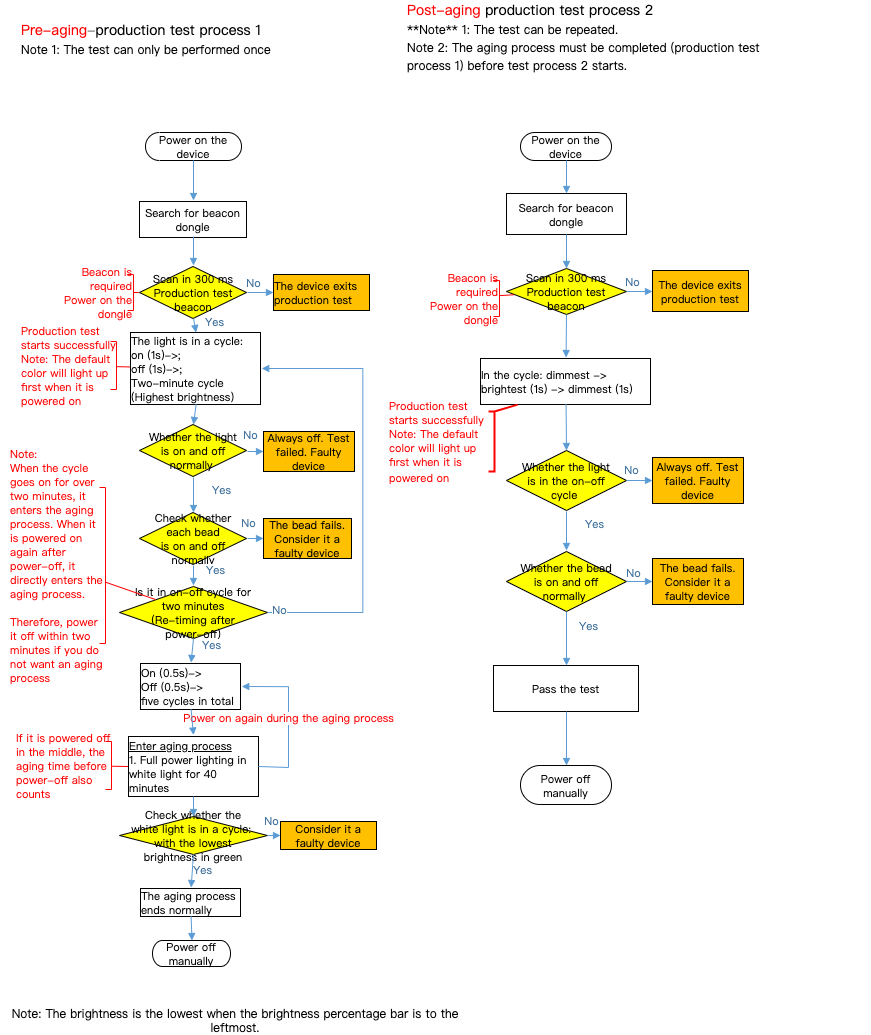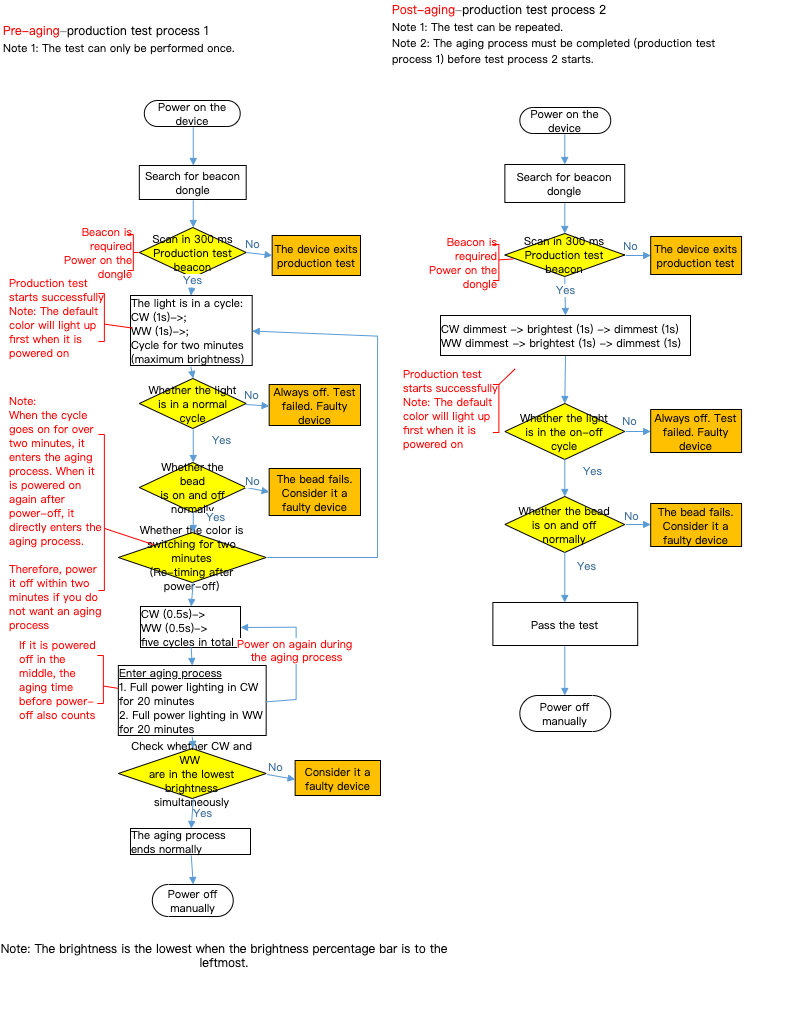Zigbee Lighting Product Testing
Last Updated on : 2024-11-20 02:12:21download
This topic describes how to perform a production test on a Zigbee lighting product that is developed with a no-code solution. The Zigbee functionality and the communication between the Zigbee module and the microcontroller will be verified.
Background
The testing process is divided into pre-aging and post-aging stages. The pre-aging test can be completed only once. To perform an after-aging test, you must first complete the pre-aging test. The post-aging test can be repeated as needed.
Applicability
The testing processes apply to Zigbee lighting products developed using no-code solutions and firmware that supports repeated after-aging tests.
Testing metrics
| Type | Requirement |
|---|---|
| Cool white light | The light can repeat this pattern: darkest > brightest (for one second) > darkest (for one second) |
| Warm to cool white light | The light can repeat this pattern: cool white at its darkest > brightest (for one second) > darkest (for one second) > warm white at its darkest > brightest (for one second) > darkest (for one second) |
| Colored light | The light can repeat this pattern: red at its darkest > brightest (for one second) > darkest (for one second) > green at its darkest > brightest (for one second) > darkest (for one second) > blue at its darkest > brightest (for one second) > darkest (for one second) |
| Cool white and colored light | The light can repeat this pattern: red at its darkest > brightest (for one second) > darkest (for one second) > green at its darkest > brightest (for one second) > darkest (for one second) > blue at its darkest > brightest (for one second) > darkest (for one second) > cool white at its darkest > brightest (for one second) > darkest (for one second) |
| White and colored light | The light can repeat this pattern: red at its darkest > brightest (for one second) > darkest (for one second) > green at its darkest > brightest (for one second) > darkest (for one second) > blue at its darkest > brightest (for one second) > darkest (for one second) > cool white at its darkest > brightest (for one second) > darkest (for one second) > warm white at its darkest > brightest (for one second) > darkest (for one second) |
Preparation
| Device | Quantity | Notes |
|---|---|---|
| Device under test | As per your needs | / |
| Zigbee dongle | At least one | The Zigbee dongles are sold on the Tuya Developer Platform. |
Things to note
- The distance between the Zigbee dongle and the device under test (DUT) should be within 1.5 meters without any obstruction.
When using an enclosed aging rack, be sure the Zigbee signals are not obstructed by metal or other materials.
- Up to 200 DUTs can be connected to the same Zigbee dongle for one test to minimize signal interference. If you have a large number of DUTs, You can either add Zigbee dongles or perform tests in batches.
- Remove these paired devices from the SmartLife app or OEM app and power them off 10 seconds later.
- The pre-aging test can be completed only once. The post-aging test must be performed after the pre-aging test is completed. The post-aging test can be repeated as needed.
Testing process
-
Cool white light

-
Warm to cool white light

-
Colored light

-
Cool white and colored light

-
White and colored light

Procedure
This section uses white and colored light as an example to describe the steps to test a lighting product.
Pre-aging test
-
Power on all the DUTs and check if their initial state is correct, which should either be a steady-on light or a quick blink.
- If all the DUTs are in the correct initial state, proceed to the next step.
- If some DUTs do not behave as expected in the initial state, power all the DUTs off for 15 seconds and power them back on. If a DUT still fails to behave correctly in the initial state, it is defective.
-
After all the DUTs are in the correct initial state, power them off.
-
Turn on the Zigbee dongle and configure it to BC mode, channel 11, and POW 19. For more information about the Zigbee dongle, see Set Zigbee Dongle.

-
Power on all the DUTs. The module will automatically scan for the signals emitted by the Zigbee dongle.
-
Check if the module enters the test mode.
After the module detects the Zigbee dongle at the moment of power-on (within 300 ms), the DUT then lights up in a pattern of red, green, blue, cool white, and warm white for two minutes with each color lasting one second. The brightness remains at 100% throughout the cycle.- Typically, all the DUTs toggle colors simultaneously. If most of the DUTs do not behave simultaneously, power all the DUTs off and inspect the testing environment. Try moving the Zigbee dongle closer to the DUTs.
- To prevent your work-in-process DUTs from entering the aging process, power them off within the first two minutes of the color cycle.
- If a specific DUT is behaving differently from the others, try power cycling it. If the problem persists, then consider this DUT defective.
- If you power cycle a DUT within the first two minutes of the color cycle, the timer for the color cycle will be reset.
-
Observer the DUTs’ state after two minutes of the color cycle.
All the DUTs cycle through red, green, blue, cool white, and warm white five times and then remain steady-on in cool white. During the aging process, the DUTs cycle through cool white (for 20 minutes), warm white (for 20 minutes), and RGB (for 10 minutes). -
After the aging process is completed, observe the DUTs’ state.
All the DUTs should light in dark green. Any DUT that fails to do so is defective. -
Power the acceptable DUTs off.
The pre-aging test has been completed.
Post-aging test
- Perform steps 1 to 5 of the pre-aging test to check if the module has been authorized by observing whether the DUT enters a color cycle.
The color cycle is: red at its darkest > brightest (for one second) > darkest (for one second) > green at its darkest > brightest (for one second) > darkest (for one second) > blue at its darkest > brightest (for one second) > darkest (for one second) > cool white at its darkest > brightest (for one second) > darkest (for one second) > warm white at its darkest > brightest (for one second) > darkest (for one second) - If a DUT still fails to behave correctly, it is defective.
- Power the acceptable DUTs off.
The test has been completed.
Is this page helpful?
YesFeedbackIs this page helpful?
YesFeedback





